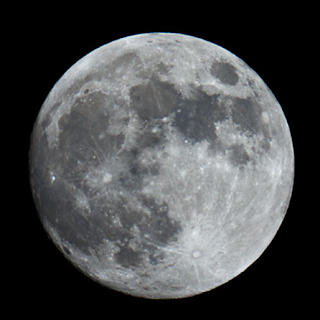Bree asked about the super Moon. And so started The Rant! I think she got a bit more than she bargained for...
I explained that this was all media hype. Selling newspapers! A disproportionate inflation of an event.
The reference to "super" Moon was that our natural satellite was closer to the Earth than at other times and therefore bigger and brighter. But I cautioned that if one was examining the Moon with just their eyes, they would not be able to see the difference. The next full Moon would be fractionally larger than the previous month's full phase. And it would be a tiny bit brighter. But a casual observer, using their eyes would not be able to tell. If carefully photographing the Moon over each full Moon phase and comparing the results, one would see the very slight difference in size. Joel also referred to a surveying instrument in his field that could measure this. To measure the change in brightness would require specialised light-sensitive equipment.
The Moon's orbit is elliptical. At times it is closer than average; other times further. This is known as perigee and apogee. And the Moon has been doing this for millions of years. Long before humans began observing the Moon and long before we starting keeping detailed records and measuring things. I wondered if people on the coasts, say in the Maritimes, found the whole super Moon business silly. Of course, the Moon at perigee could make for larger tides. Joel nodded in agreement. I knew the term "neap tide;" at the time I couldn't remember the other. [ed: "spring tide," which is the higher tide, during new and full Moon phases.]
This also gave me the opportunity to address the illusion effect, when the Moon is near the horizon. I showed Bree show to measure the Moon's diameter against her pinkie fingernail. I encouraged her to use this standard any time she thought the Moon looked different. She might be surprised.
Now all that said, I'm happy that people are talking about celestial objects and looking up in the night sky 'cause it's cool and all. The more we can talk about astronomy and science and physics the better.
I shared I was worried about the crying wolf effect. That civilians going outside will say, "Huh. Moon looks the same. Nothing special." And feel disappointed or even upset. And then in the future not bother getting off the couch.
Nothing super about it.
When the bright Moon emerged from the mottled clouds, we measured it.
Subscribe to:
Post Comments (Atom)




No comments:
Post a Comment